Which countries have the highest risk of chronic diseases?
Chronic diseases, or noncommunicable diseases, are categorized as non-contagious conditions that are chronic in nature, and unfortunately, they contribute to around three-quarters of all deaths globally.
Despite the longevity of these illnesses, people with chronic conditions can still live long and happy lives, as advancements in technology and research have meant that prescription drugs and the proper medical treatments can manage these diseases.
Risk factors for chronic diseases can include environmental, genetic, and behavioral influences and can differ between conditions. Because of this, certain cultures and lifestyles may be more likely than others to develop certain long-term illnesses.
To understand the current state of chronic conditions around the world, we have compiled a range of global data, including the cost each country spends on pharmaceuticals, the prevalence of each disease, and the death rate of each chronic disease.
Hypertension is the most common chronic illness in the U.S.


Chronic conditions can affect your body in many ways depending on your diagnosis, but which are the most common across the U.S.? Based on annual data, here’s what we found.
-
Hypertension
63.44% average prevalence across the U.S.
Hypertension, also known as high blood pressure, is a common condition characterized by symptoms including severe headaches and chest pain. From old age to a high salt diet and excessive alcohol consumption, many factors can increase your risk of developing the condition.With this in mind, it may not be surprising that hypertension is the most prevalent chronic illness in the U.S., affecting almost two-thirds of U.S. residents on average.
-
Diabetes
24.56% average prevalence across the U.S.
Diabetes is a chronic condition that occurs when blood sugars are too high and can be diagnosed under two main types. Type 1 diabetes is an autoimmune disease and is usually developed during childhood. In contrast, type 2 is more commonly diagnosed in adults and is generally brought on as a result of lifestyle choices.Even though diabetes is the second-most common chronic illness in the U.S., the development of treatments has meant that it is rarely fatal. While most people can manage this condition, it can greatly affect daily life. To reduce your chances of developing type 2 diabetes, you should avoid a high sugar intake and, if possible, complete around 30 minutes of moderate physical activity at least 5 days a week.
-
Obesity
19.26% average prevalence across the U.S.
Obesity affects more than a billion people all over the world1, and the U.S. is no exception. Just under a fifth of Americans are classified as obese, characterized as having an excessive body fat accumulation that presents a health risk.Obesity is classed as a chronic disease due to the long-term imbalance between the expenditure and intake of energy, leading to a whole host of health problems, including type 2 diabetes and cardiovascular diseases. Fortunately, this condition can be managed if you adopt a healthy and active lifestyle, and in some cases taking weight-loss drugs or undergoing bariatric surgery may be recommended.
Chronic disease prevalence broken down by U.S. state
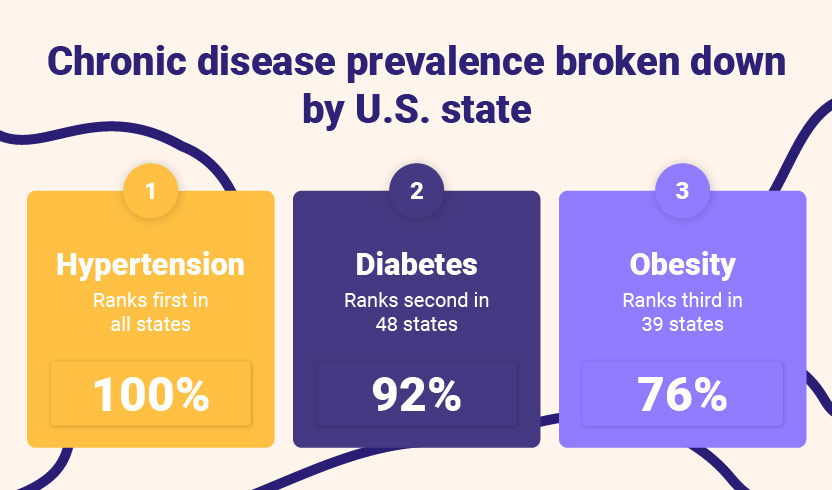

We have revealed the prevalence of chronic diseases across the U.S., but which states are suffering most with these conditions?
As previously mentioned, hypertension has the highest national average prevalence of any chronic disease, but when it comes to states, Mississippi’s figure is higher than any other, totaling 74%.
Aside from hypertension, some of the other most common long-term conditions in the U.S. include diabetes, obesity, and chronic kidney disease. When broken down by state, New York, West Virginia, and Mississippi have the joint-highest prevalence of diabetes, with 30% of their respective populations living with this diagnosis. Obesity and chronic kidney disease are most widespread in Alabama and Hawaii, respectively. Unfortunately, Hawaii also has the highest percentage of osteoporosis cases state-wide, with diagnoses across 15% of residents here.
Connecticut is among the states with the highest prevalence for four different chronic diseases, including Alzheimer’s (9%), asthma (9%), cancer (13%), and Parkinson’s (2%).
According to the most recent data, heart failure affects roughly 11% of the U.S. population, but these figures increase to 14% in Alabama and Oklahoma.
Hungary has the highest percentage of deaths from chronic diseases, at almost 94%


While chronic diseases are long-term conditions, they aren’t always a person’s cause of death. With this in mind, we can reveal which OECD countries suffer from the most significant percentage of chronic disease-related deaths.
- Hungary
93.90% of total deaths are from chronic diseases
Some of the most prevalent chronic illnesses in Hungary are cardiovascular disease and cancer. Lifestyle choices, such as smoking, can increase the likelihood of contracting a chronic disease. Unfortunately, as Hungary has one of the highest smoking rates in the EU2, it may explain why almost 94% of deaths in this country are the result of chronic illnesses. -
Finland
92.90% of total deaths are from chronic diseases
Next on this list, with just less than 93% of total deaths coming from chronic diseases, is Finland. This European country is home to an aging population. While it is good that residents here have longer life expectancies, it also increases the risk of developing a chronic illness.In an attempt to reduce the likelihood of residents being diagnosed with chronic diseases, this country has clamped down on preventable risk factors like alcohol and smoking.
-
Estonia
92.20% of total deaths are from chronic diseases
Similarly to the other entries in this list, the majority of deaths from chronic diseases in this country come from cardiovascular conditions, with females being affected by more fatal heart-related diseases than their male counterparts.Estonia has suffered from challenges in healthcare funding over the years, making it more difficult to manage the diagnosis and treatment of chronic diseases. Unfortunately, more than 92% of all deaths in this country are the result of chronic illnesses.
The most fatal chronic diseases in OECD countries
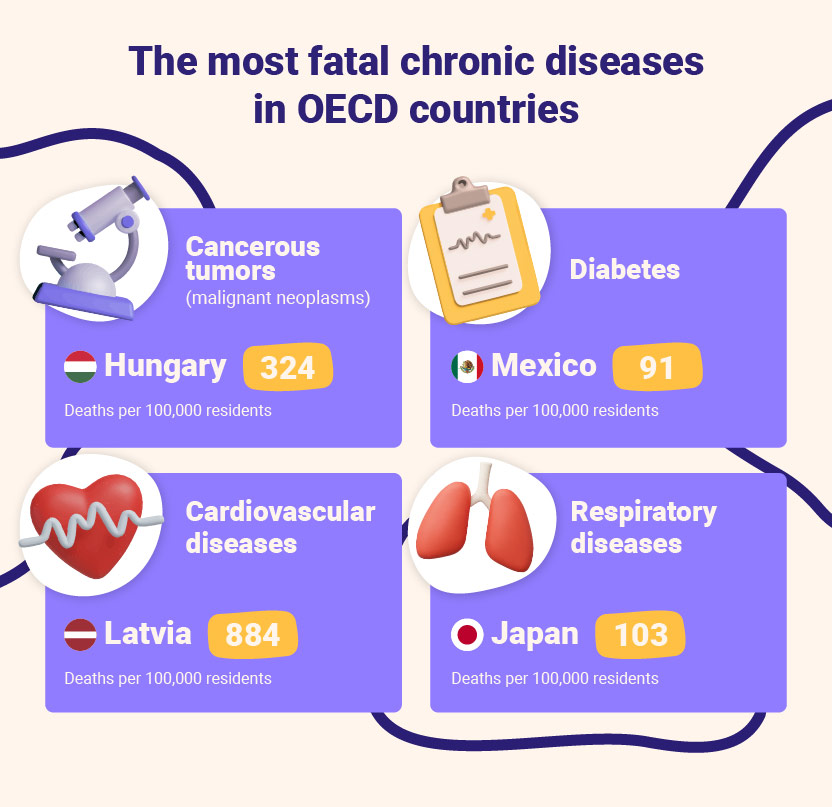

Noncommunicable diseases are responsible for millions of deaths every year, with risk factors making some cultures more susceptible than others. Below is a breakdown of some of the most common chronic diseases and the countries that are most affected by related fatalities.
Cancerous tumors (malignant neoplasms)
Hungary - 324 deaths per 100,000 residents
With 324 deaths per 100,000 residents, Hungary experiences more fatalities than any other OECD country when it comes to cancerous tumors.
Unlike benign tumors, which are contained in one area, malignant cancers are often fatal as they spread across the body. When broken down by gender, it appears that these illnesses are more common among men than women in this country.
Diabetes
Mexico - 91 deaths per 100,000 residents
The prevalence of diabetes in the U.S. has already been detailed, but when it comes to diabetes-related fatalities, Mexico is the most affected. According to the most recent figures, more than 110,000 deaths were attributed to this chronic disease across the country in one year, which equates to 91 deaths per 100,000 residents.
Cardiovascular diseases
Latvia - 884 deaths per 100,000 residents
Based on recent data, Latvia is revealed as the OECD country most at risk of cardiovascular disease-related fatalities. When taking the population of this European country into account, the 16,927 cardiovascular fatalities here are equivalent to 884 deaths per 100,000 residents. While family history may make you more susceptible to cardiovascular diseases, smoking and physical inactivity are also significant risk factors.
Respiratory diseases
Japan - 103 deaths per 100,000 residents
Respiratory diseases include conditions such as chronic obstructive pulmonary disease, and unfortunately, they often lead to fatalities as a result of their breathing-related symptoms. Of all the OECD countries in the world, Japan sees more deaths from respiratory diseases than any other, totaling 103 per 100,000 residents.
Greece spends the most on pharmaceuticals, at 27% of all healthcare spending
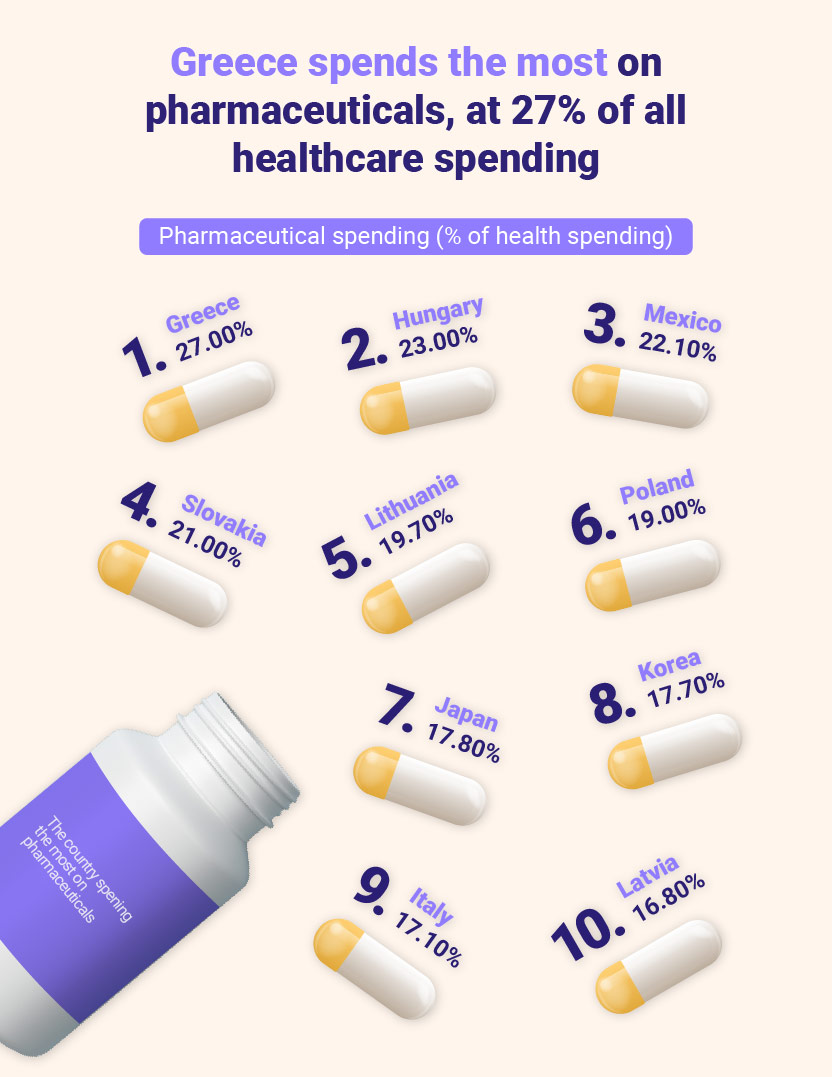

The longevity of chronic diseases means that medications are regularly prescribed to sufferers to help them manage symptoms. Bearing this in mind, we have revealed which OECD countries are spending the most on pharmaceuticals as a proportion of all health expenditures.
-
Greece
Pharmaceuticals make up 27.00% of all health spending
According to the most recent data, Greece is spending around €2.6 billion on pharmaceuticals per year, which equates to more than a quarter of all health spending in this country.Despite having the highest percentage of pharmaceutical spending of all the countries on our list, Greece has recently experienced a shortage of over-the-counter medication3 due to a lack of resource availability.
- Hungary
Pharmaceuticals make up 23.00% of all health spending
Next on our list, with pharmaceuticals accounting for 23% of all health expenditures, is Hungary. After appearing at the top of one of our previous chronic condition-related rankings, it may come as no surprise that Hungarian residents are spending a large amount of money on prescription medicine to help manage their illnesses. - Mexico
Pharmaceuticals make up 22.10% of all health spending
Mexico has the third-largest proportion of pharmaceutical expenditures among OECD countries. From respiratory infections to outbreaks of infectious diseases, Mexico has faced a series of public health issues over the years. As a result, the need for over-the-counter prescriptions has increased, which has likely contributed to the country’s position on this ranking.
Which chronic diseases are the U.S. searching about the most?


From understanding symptoms to getting help with disease management, many of us use Google as a source of medical information. But which chronic conditions are being researched the most? Here’s what we found.
-
Attention deficit hyperactivity disorder (ADHD)
49,740 related Google searches
ADHD is a behavioral condition that affects millions of Americans nationwide. Symptoms of ADHD look different from case to case, but some of the most common include impulsivity and difficulty concentrating.The restlessness-related symptoms associated with ADHD can impact people with this condition in many aspects of their daily lives, from staying focused on tasks during the day to sleeping at night. With this information in mind, it is understandable that many people are using Google to find out how to deal with this condition, with almost 50,000 searches in the last year alone.
-
Multiple sclerosis (MS)
34,370 related Google searches
Multiple sclerosis is the next chronic condition on this list, with over 34,000 annual Google searches from people wanting to learn more about managing it. The causes of this autoimmune disease are not fully understood, but any part of the central nervous system can be affected.Although there is currently no cure for MS, treatments can range from steroid medicine to physiotherapy and mobility equipment, all of which can help people live with the condition.
-
Chronic obstructive pulmonary disease (COPD)
31,090 related Google searches
The third disease to appear here is chronic obstructive pulmonary disease, a group of respiratory conditions that cause long-term breathing problems. Of the 31,090 related Google searches for this disease, around two-thirds asked about ‘managing chronic obstructive pulmonary disease.’If you are struggling to live with this condition, the best way to help manage symptoms is by not smoking. Exercising regularly and using inhalers will also help to control the disease.
The average age of menopause around the world
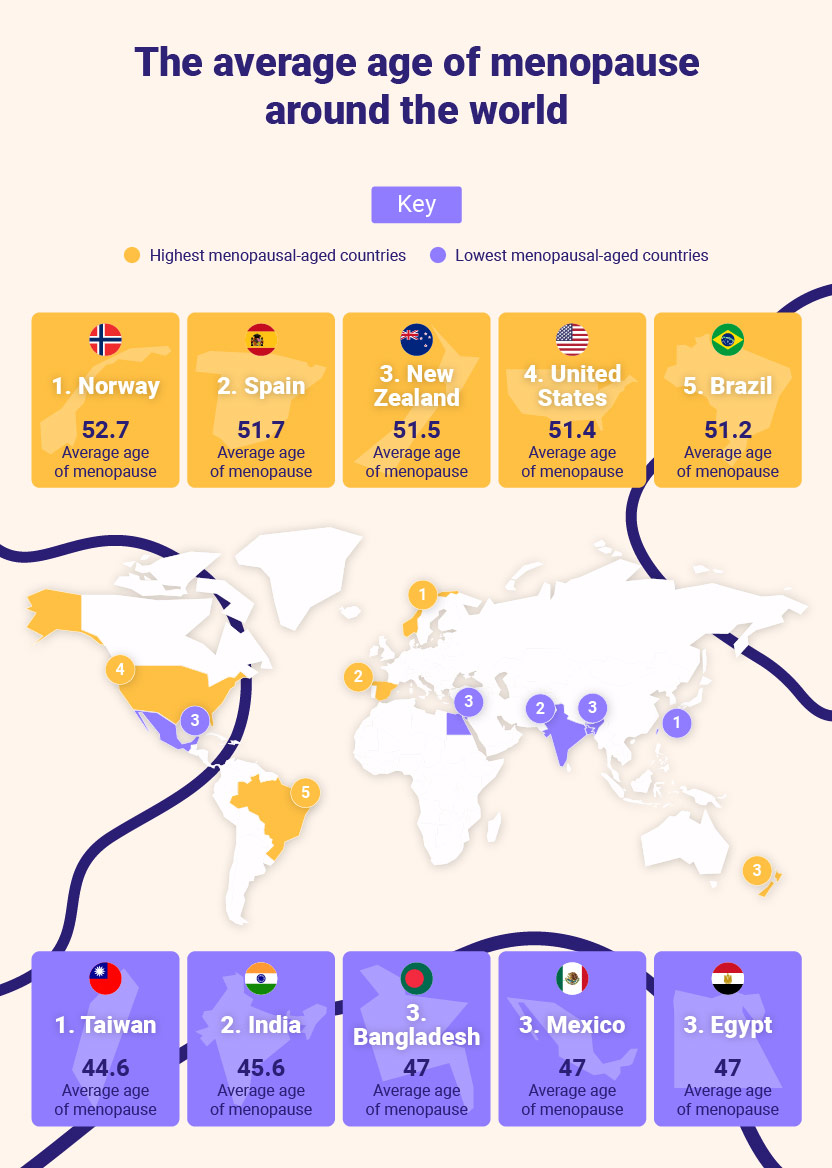

Menopause is an entirely natural transition and is diagnosed when a woman goes more than 12 months without menstruating or vaginal bleeding. The onset of menopause generally occurs between the ages of 45 and 55, and we can reveal how the average age of menopause differs across the world.
Four of the five highest menopausal-aged countries on this list are OECD nations. Women in Norway average 52.7 years old when they reach the end of reproduction, which is later than anyone else. Following closely behind are Spain, New Zealand, Brazil, and the US, which all have average menopause ages spanning 51 years.
According to the most recent data, women in Taiwan are more likely to experience menopause-related symptoms earlier than most, with the age of menopause here averaging just 44.6 years. The top three youngest average menopause ages are located in countries within Asia, suggesting that ethnic differences may be at play.
Countries with the highest breast cancer rate
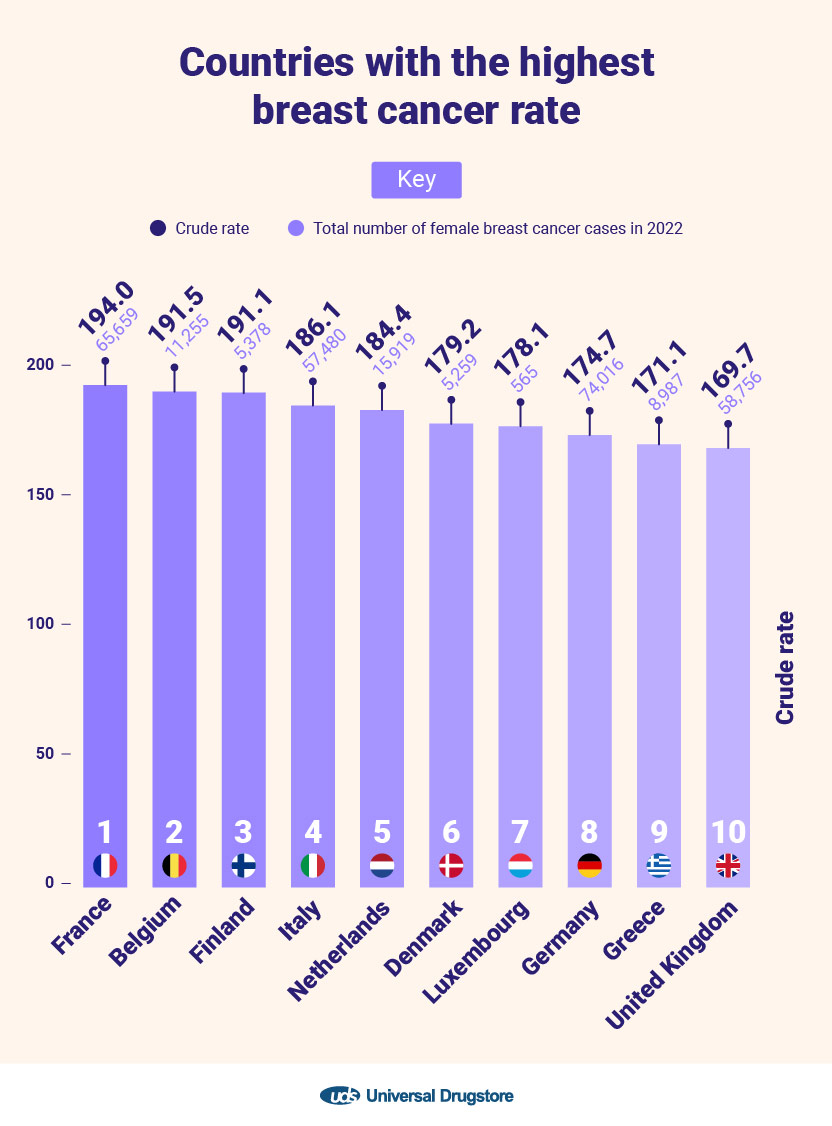

While men can still be affected by breast cancer, the vast majority of cases are amongst women, and it remains one of the biggest causes of cancer-related deaths for this gender. To understand more about the current state of breast cancer across the world, we have ranked OECD countries based on incidence-related crude rates.
- France
194.0 breast cancer crude rate
According to the most recent data, French residents are more prone to breast cancer than any other on our list, with a crude rate of 194.0. Many factors have been associated with an increased risk of the development of breast cancer, including a high alcohol and smoking consumption rate, among others. - Belgium
191.5 breast cancer crude rate
With a crude rate of 191.5, Belgium appears next on this list. This European country may have a lot fewer annual cases of breast cancer than its neighbor, France. Still, when population is considered, women in this country are proportionally more susceptible to the disease than most. - Finland
191.1 breast cancer crude rate
Around 5,000 people are diagnosed with breast cancer in Finland every year, and this equates to a high incident crude rate of 191.1. Having said this, the country’s efforts to encourage nationwide screenings have meant that cases of this condition are often treatable.
Methodology
We used the World Bank Group to find the population and the number of deaths caused by noncommunicable diseases as a percentage of total deaths for each OECD country in 2019.
We used OECD data to calculate pharmaceutical spending as a percentage of total health expenditure for each country as of 2021.
We used the World Health Organization to find the number of deaths attributed to the following chronic illnesses as of 2019 for males, females, and both sexes: cancerous tumors, diabetes, cardiovascular diseases, and respiratory diseases.
We divided the number of deaths for each disease by each country’s population before multiplying this by 100,000 to find the number of attributed deaths per 100,000 residents.
We used the Centers for Medicare & Medicaid Services to find the prevalence of a range of chronic diseases in each U.S. state based on 10,000 beneficiaries as of 2022. Using each state’s data, we found the average overall prevalence of each disease across the U.S.
We used Google Ads Keyword Planner to find the total number of Google searches for the terms ‘managing CONDITION,’ ‘how to manage CONDITION,’ ‘dealing with CONDITION,’ and ‘living with CONDITION’ between August 2023- July 2024.
We used the World Health Organization to find the number of female breast cancer cases and crude rate for each OECD country as of 2022.
Finally, we used World Population Review to find the average age of menopause in each country as of 2024.
Additional sources:
- https://www.worldobesity.org/about/about-obesity/prevalence-of-obesity#:~:text=Obesity%20is%20now%20recognised%20as,risk%20to%20health%20than%20underweight
- https://ec.europa.eu/eurostat/databrowser/view/hlth_ehis_sk1c/default/table?lang=en
- https://www.trade.gov/country-commercial-guides/greece-healthcare#:~:text=Greece%20is%20one%20of%20the,deficits%20and%20payment%20delays%20suppliers








